AustLit
Latest Issues
AbstractHistoryArchive Description
Notes
-
Epigraph: 'Aboriginal artists mapping our countries, exploring the new, recovering old known ways. Charting our existence, defending our territiories, proving our ancestral connections...' From 'holding the map upside down', Judy Watson 1999
-
Editor's note: This is number one hundred and fourteen in the second numbered series of the Miegunyah Volumes made possible by the Miegunyah Fund established by bequest under the wills of Sir Russell and Lady Grimwade.
'Miegunyah' was the home of Mab and Russell Grimwade from 1911 to 1955.
-
Includes:
- Index
- Bibliography (p. 223-234)
Publication Details of Only Known VersionEarliest 2 Known Versions of
Works about this Work
-
The Poetics of (Re)Mapping Archives : Memory in the Blood
2014
single work
criticism
— Appears in: JASAL , vol. 14 no. 3 2014;'This paper explores stories of re-mapping the archives through art and poetic-prose, using ideas of haunting through ‘memory in the blood.’ Our family archives are like maps that haunt and guide us toward paths past-travelled and directions unknown. We travel through these archives that offer up new stories and collections of data, and a brutal surveillance is exposed at the hands of the State. We gain insight into intimate conversations, letters, behaviours and movements, juxtaposed with categorisations of people, places, landscapes and objects. These records are our memories and lives; material, visceral, flesh and blood. The State wounds and our records bleed. I travel through my own Nanna’s records and recognise that we have never lived outside the State, and this very act of recognition continues the wounding. State acts of surveillance, recording and archiving had the power to place our
family stories in the public domain, or obliterate stories within a broader history of erasure; filed away, silent and hidden until bidden. But our bodies too are archives where memories, stories, and lived experiences are stored, etched and anchored in our bloodlines deep. They ground our creativity in what become personal and political acts of remembering, identity making and speaking back to the State. Detective-like methods allow us to creatively re-map events and landscapes, piece together lives fragmented and heal our wounds.' ((Re) Mapping the Archive, 4)
-
The Poetics of (Re)Mapping Archives : Memory in the Blood
2014
single work
criticism
— Appears in: JASAL , vol. 14 no. 3 2014;'This paper explores stories of re-mapping the archives through art and poetic-prose, using ideas of haunting through ‘memory in the blood.’ Our family archives are like maps that haunt and guide us toward paths past-travelled and directions unknown. We travel through these archives that offer up new stories and collections of data, and a brutal surveillance is exposed at the hands of the State. We gain insight into intimate conversations, letters, behaviours and movements, juxtaposed with categorisations of people, places, landscapes and objects. These records are our memories and lives; material, visceral, flesh and blood. The State wounds and our records bleed. I travel through my own Nanna’s records and recognise that we have never lived outside the State, and this very act of recognition continues the wounding. State acts of surveillance, recording and archiving had the power to place our
family stories in the public domain, or obliterate stories within a broader history of erasure; filed away, silent and hidden until bidden. But our bodies too are archives where memories, stories, and lived experiences are stored, etched and anchored in our bloodlines deep. They ground our creativity in what become personal and political acts of remembering, identity making and speaking back to the State. Detective-like methods allow us to creatively re-map events and landscapes, piece together lives fragmented and heal our wounds.' ((Re) Mapping the Archive, 4)




